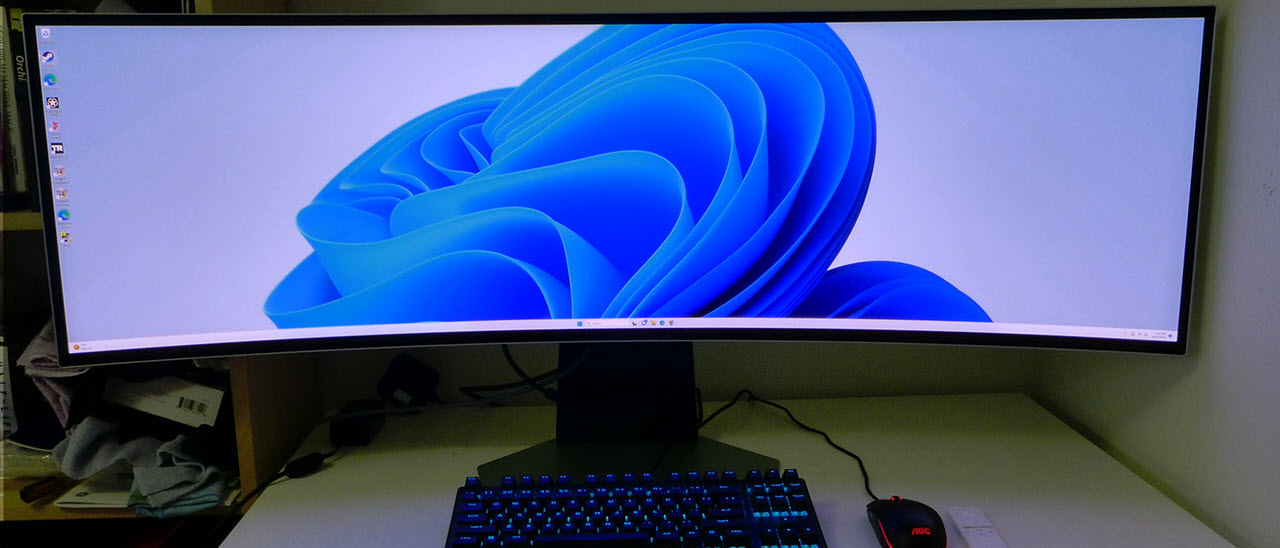Tom's Hardware Verdict
The Samsung Odyssey OLED G9 is loaded with features that make it a one-piece entertainment solution. It’s gorgeous to look at and a blast to play games on. With stunning picture quality, its premium price tag is more than justified.
Pros
- +
Stunning image with deep contrast and saturated color
- +
No need for calibration
- +
Top-tier gaming feel and performance
- +
Excellent audio from integrated speakers
- +
Samsung TV Plus and Game Hub for online content streaming
- +
Wi-Fi, Bluetooth and Apple AirPlay
- +
Premium build quality
Cons
- -
Complex and disjointed menu system
- -
No sRGB mode
Why you can trust Tom's Hardware
Is it a gaming monitor or a TV? I’ve asked that question once before in my review of the Samsung OLED G8, and I’m asking it again as I unpack the OLED G9. Like the G8, it’s a curved wide screen, 49 inches in the 32:9 aspect ratio here. It incorporates Samsung’s TV Plus and Game Hub platforms for seamless access to various streamed content libraries. It delivers shows, movies and games from powerful apps with expansion capability.
Of course, the screen is what I’m really interested in here. OLED is an emerging category in desktop monitors, and I couldn’t be happier. OLED’s super low black levels and infinite contrast mean the image has a depth and vibrance that even the best Mini LED panels cannot match. OLED is also a standout for its lack of motion blur for gaming. Where LCDs need a well-engineered overdrive or backlight strobe to maintain motion resolution, OLED does this naturally with no trickery required.
The Samsung OLED G9 is a 49-inch 32:9 screen with DQHD (Double QHD, 5120x1440 pixels) resolution, a 240 Hz refresh rate, Adaptive-Sync, HDR10 and HDR10+, wide gamut color and a ton of features to enhance every form of entertainment. Let’s take a look.
Samsung Odyssey OLED G9 Specs
| Panel Type / Backlight | Organic Light-Emitting Diode (OLED) |
| Screen Size / Aspect Ratio | 49 inches / 32:9 |
| Row 2 - Cell 0 | Curve Radius: 1800mm |
| Max Resolution and Refresh Rate | 5120x1440 @ 240 Hz |
| Row 4 - Cell 0 | FreeSync: 48-240 Hz |
| Row 5 - Cell 0 | G-Sync Compatible |
| Native Color Depth and Gamut | 10-bit / DCI-P3 |
| Row 7 - Cell 0 | HDR10, HDR10+ |
| Row 8 - Cell 0 | DisplayHDR 400 |
| Response Time (GTG) | 0.03ms |
| Brightness (mfr) | 250 nits SDR |
| Row 11 - Cell 0 | 400 nits HDR |
| Contrast (mfr) | 1,000,000:1 |
| Speakers | 2x 5w |
| Video Inputs | 1x DisplayPort 1.4 |
| Row 15 - Cell 0 | 2x HDMI 2.1 |
| Audio | 3.5mm headphone output |
| USB 3.0 | 1x up, 2x down |
| Power Consumption | 89w, brightness @ 200 nits |
| Panel Dimensions WxHxD w/base | 47 x 15.9-20.8 x 9.3 inches (1194 x 404-528 x 236mm) |
| Panel Thickness | 7.1 inches (180mm) |
| Bezel Width | Top/sides: 0.4 inch (9mm) |
| Row 22 - Cell 0 | Bottom: 0.7 inch (19mm) |
| Weight | 28.4 pounds (12.9kg) |
| Warranty | 3 years |
I’ve expounded on the benefits of OLED technology before, and the OLED G9 is a prime example of what I love. Contrast is king, both conceptually and in this gorgeous monitor. Samsung specs a million to one ratio and in my tests, I couldn’t measure the dynamic range because black levels registered below the capabilities of my instruments. That means the picture is incredibly lifelike and detailed. Sharpness is further enhanced by the 5120x1440 resolution, which equates to 109ppi. It’s the same as a 27-inch QHD panel, hence Samsung’s use of the abbreviation DQHD. The OLED G9 is the same as putting two 27-inch QHD monitors together except without a dividing line and with an 1800R curvature.
All the OLEDs I’ve tested have around 100% coverage of the DCI-P3 color gamut, making OLED the most colorful monitor category. The OLED G9 hits just over 98%. It’s accurate enough out of the box that no calibration is required. In addition to HDR10 support, it also accepts HDR10+ signals. This is Samsung’s answer to Dolby Vision and its dynamic tone-mapping. It means that content encoded in HDR10+ will adapt its tone map to the display's capabilities, ensuring that all highlight detail remains visible, increasing perceived contrast and image fidelity.
The OLED G9 is, like all OLEDs, a very capable gaming monitor. The max refresh rate is 240 Hz, which means motion blur is completely eliminated. You’ll need a decent video card to achieve 240fps, but any frame rate over 150fps in practice is incredibly smooth. Input lag is also quite low, on par with the best gaming monitors I’ve tested. Adaptive-Sync comes in both FreeSync and G-Sync forms and works at the full refresh rate for both SDR- and HDR-enabled games. The OLED G9 has been certified by Nvidia.
In addition to its prowess as a gaming monitor, the OLED G9 serves as a television. Samsung’s well-developed TV Plus and Gaming Hub software make a vast amount of TV, movie and gaming content available. You can conceivably use built-in Wi-Fi without an external video source. An included remote controls the fun. With decent audio from the integrated speakers, the OLED G9 is its own desktop theater. At this writing, it’s selling for $1,400, so that entertainment is firmly in the premium category. But it offers so much that the value is apparent.
Get Tom's Hardware's best news and in-depth reviews, straight to your inbox.
Assembly and Accessories
The OLED G9’s long, slender carton is packed with crumbly foam and protects the contents well. The base and upright bolt together and the panel snaps in place. You’ll need to make some room for its nearly four-foot width, but it isn’t significantly deeper than any other large monitor. A steel adapter bracket is provided with the standard 100mm VESA spec if you want to use an arm. An enormous external power supply is provided with a right-angle power cord. The only other cable I found was DisplayPort.
Product 360
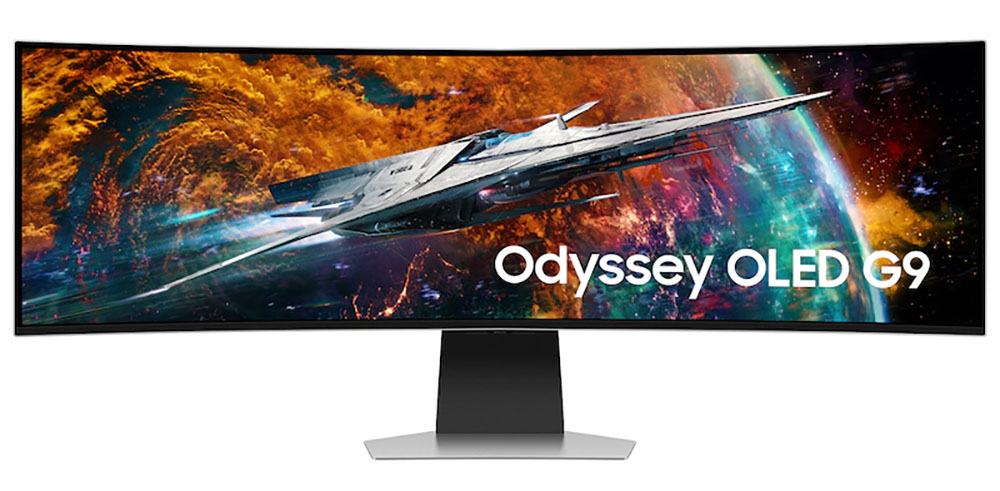


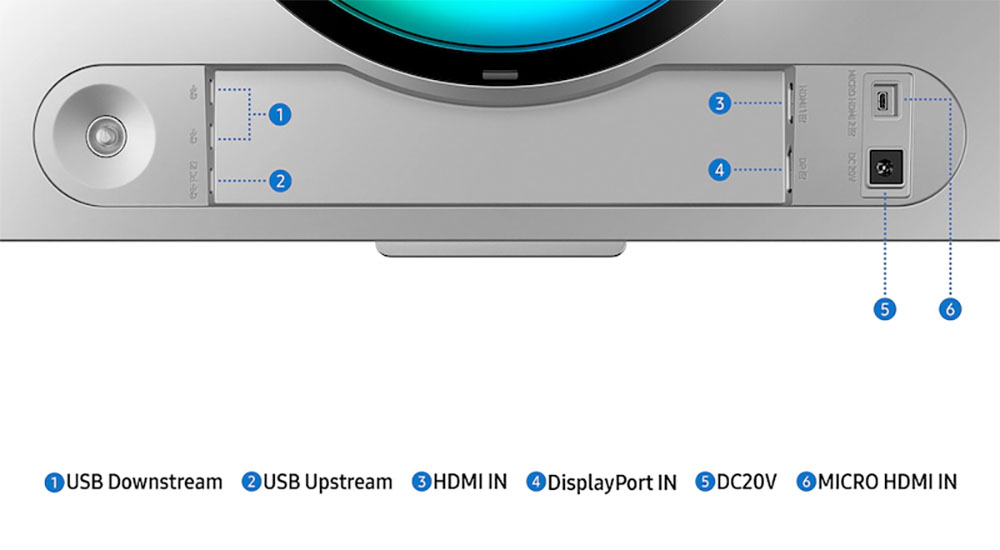
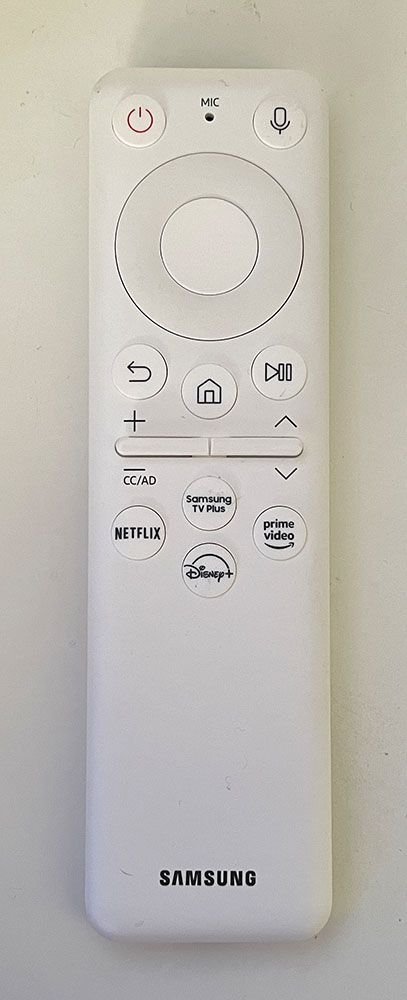
As I said above, you’ll need a lot of space to accommodate the OLED G9’s four-foot width. But since it’s less than 10 inches deep, you can push it back a bit in order to take it all in. While it’s tempting to sit close since its pixel density is high, finding a spot where you won’t need to swivel your head too much while playing is better. Keeping the entire image within peripheral vision makes it easier to maintain situational awareness. The 1800R curve isn’t severe, so you won’t experience any image distortion in either graphics or text. The OLED G9 is as well-suited for both work and play.
The high-quality chassis has an all-metal back panel, solid metal base and stout upright. The stand has a 4.9-inch height adjustment with 2/15 degrees tilt. There is no swivel. Movements are super smooth and befit a premium product. At nearly 30 pounds, the OLED G9 is stout and substantial.
The LED lighting appears as a colored ring around the panel attachment point. It’s called Core Lighting and includes a choice of colors and effects. It can be set to follow the action on the screen if you like or shut off entirely.
There’s also a unique input panel in the back. The jacks are inside a cavity and face towards the center to keep plugs from protruding out the back. Exceptions are the power and mini-HDMI inputs, which point toward the wall. The main inputs are standard size, unlike the mini plugs I encountered on the OLED G8. You get two HDMI 2.1 and one DisplayPort 1.4 along with one upstream and two downstream USBs. In the photo, you can see the control joystick, which covers all monitor functions and toggles power.
A tiny remote is included for controlling the Samsung TV Plus and Game Hub features. It includes hotkeys for Netflix, Disney+ and Prime Video as well as transport keys and navigation. It also has a microphone for voice control through Alexa and Google Assistant.
OSD Features
The OLED G9’s OSD is slightly confusing because it comes in multiple versions. One is focused on gaming and appears at the bottom of the screen, while another looks like Samsung’s standard TV menu. The gaming one is summoned by holding the play/pause key on the remote, while the TV version comes up when you press the joystick. To further complicate matters, there are settings available in the TV Plus interface that overlap what’s found in the other menus.

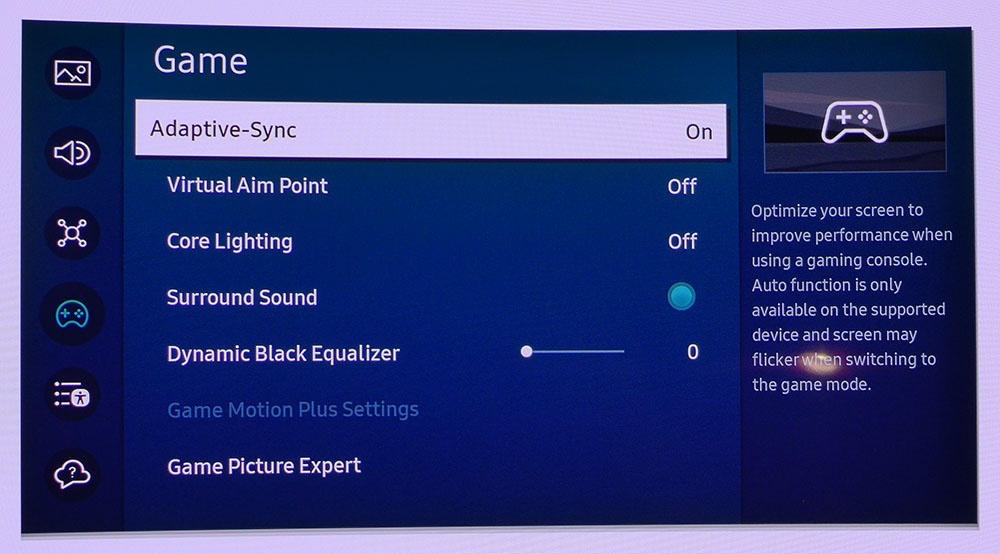
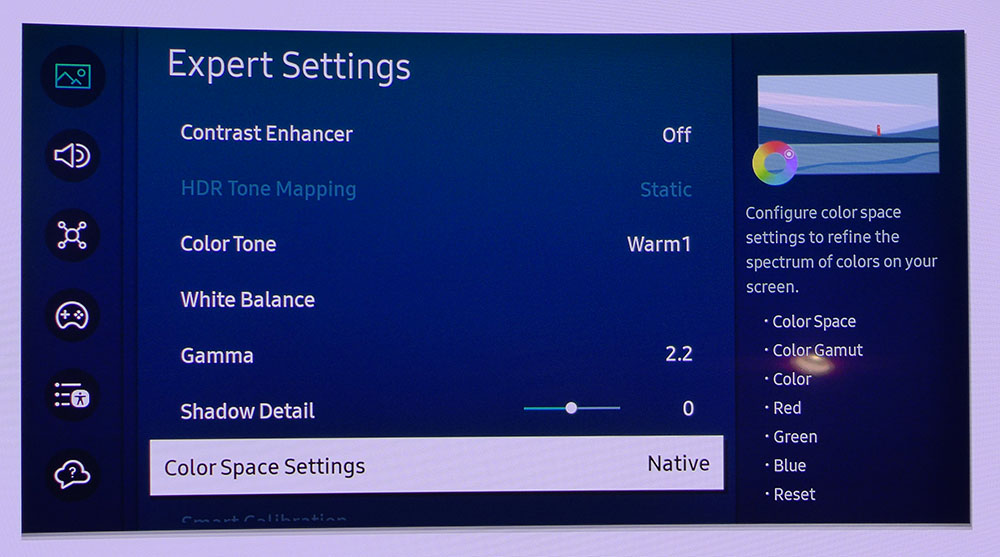
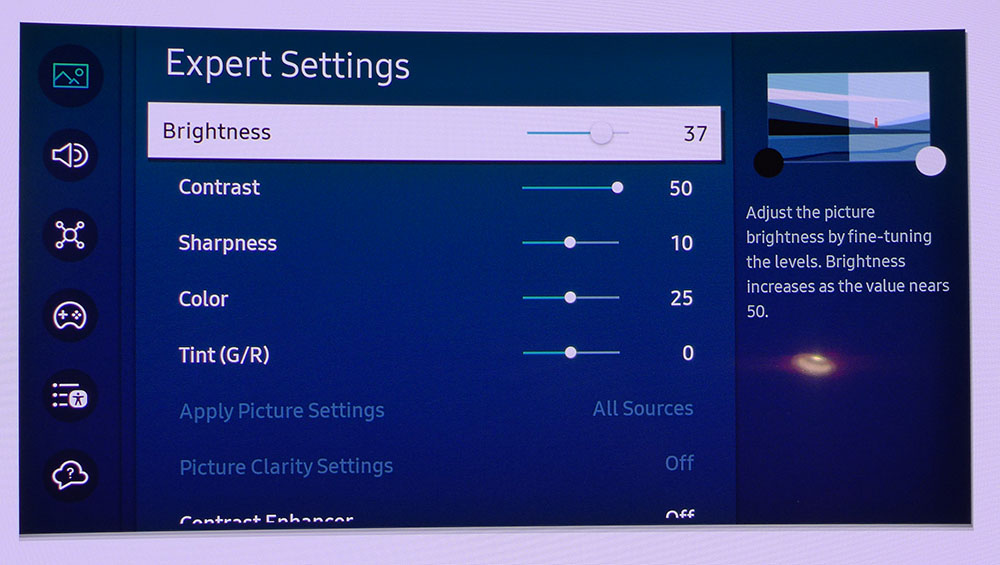

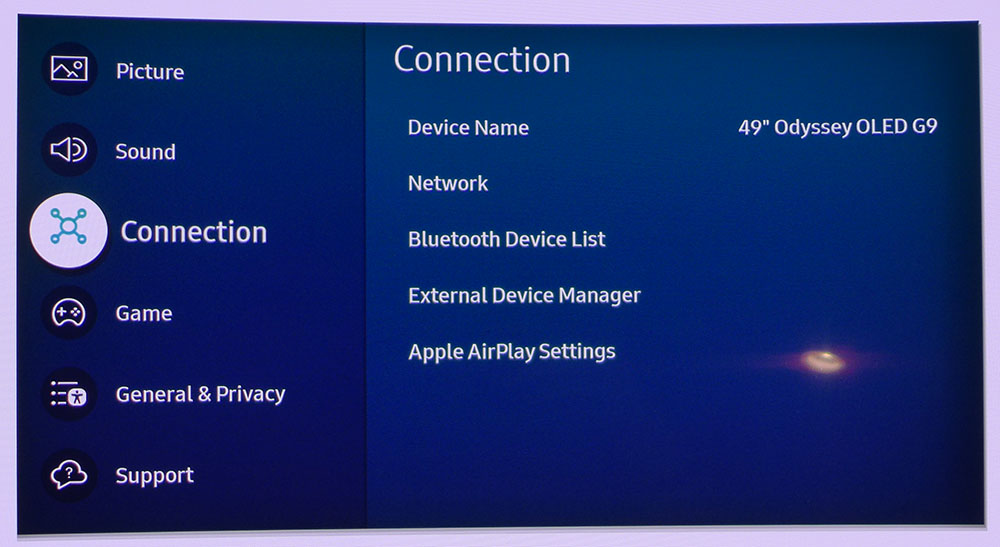

The first photo shows the OLED G9’s gaming menu that appears when you press play/pause on the remote. It has its own set of picture modes aimed at different game types. I found Original to be the closest to color standards. There are also options for audio and HDR.
The main menu looks like photo two above and has five sections plus a slick integrated user manual. The game menu includes aiming points, LED lighting control and additional video processing options in the Game Picture Expert section.
If you want to tweak the OLED G9’s image, the first sub-menu, Picture, has everything needed to adjust color temperature, gamma and gamut. White Balance comes in 2- and 20-point versions if you want to get really picky. I was able to improve the already excellent grayscale tracking with a few clicks of the RGB sliders in the 2-point menu. Gamma can be set to 2.2 or BT.1886, which is rarely seen on computer monitors. 1886 is a television standard that hasn’t found its way into many games. It looks a bit darker than 2.2.
The internal speakers are of better-than-average quality and include sound modes with a convincing surround simulation option. You can tweak the settings in the Sound menu to produce a surround effect on the desktop.
The OLED G9 supports Wi-Fi and Bluetooth wireless connections. It also includes Apple AirPlay. Bluetooth means using external game controllers or listening to music streamed from a phone or tablet. Playing music via AirPlay means no compression, a sonic improvement you can easily hear.
If you get lost in the G9’s vast sea of features and options, a full user manual is just a few clicks away. It’s well organized, so you can find information on every setting with detailed explanations.
Samsung Odyssey OLED G9 Calibration Settings
The OLED G9 makes different picture modes available depending on whether you access the main menu or the game menu. Through the HDMI port, I did my tests and calibration using the main menu, which starts you out in Eco mode. This limits brightness and has an odd color tone. Switching to Movie fixed that quickly. In fact, calibration was unnecessary, though I could perform one anyway. The settings are provided below and will work for SDR content. The game menu has its own set of modes. I recommend using Original there for the most accurate image.
| Picture Mode | Movie |
| Brightness 200 nits | 37 |
| Brightness 120 nits | 15 |
| Brightness 100 nits | 10 |
| Brightness 80 nits | 5 (min. 64 nits) |
| Contrast | 50 |
| Gamma | 2.2 |
| Color Temp User | Gain – Red -1, Green 1, Blue -2 |
| Row 8 - Cell 0 | Offset – Red 0, Green 0, Blue -1 |
Gaming and Hands-on
As a productivity display, the OLED G9 has an ideal curvature which is enough to bring content at the sides of the screen comfortably into view but not enough to distort geometric references like squares and gridlines. Spreadsheets take on a whole new dimension when you have this much width available. It’s easy to line up three or four documents and work on them together. Comparing different versions of the same file is also super easy.
Color and contrast are exemplary in graphics and text work. Small type is clear and clean, with strong contrast from the background. OLED contrast makes everything sharper and easier to read web pages and emails.
Gaming is also a completely different experience from other monitors. The 32:9 aspect ratio is part of that equation with its unique VR-style viewpoint of the action. You’ll see more of the virtual environment than the real world, which takes some getting used to. Once acclimated, it’s good because you’ll see your enemies before they see you.
Play feel and responsiveness are as good as the best gaming monitors I’ve reviewed, including 360 and 500 Hz models. OLED motion is so smooth and fluid that you’ll never see anything but fine detail that doesn’t break up as you move more quickly. With low input lag, the OLED G9 is well suited for competition. The 240 Hz refresh rate balances well with its DQHD resolution to provide high frame rates since it has a lower pixel count than Ultra HD screens: 7.4 megapixels versus 8.3.
HDR games like Doom Eternal and Call of Duty WWII looked sensational with deep contrast and off-the-charts color saturation. Though the OLED G9 isn’t as bright as a Mini LED panel, its black levels more than offset that deficiency. Image quality just doesn’t get better than this. I was mesmerized by the visuals, moving and static, as I fragged for hours.
I spent some time exploring the TV Plus interface with its streaming apps. They work well and are only eclipsed by an Apple TV 4K, which is my reference streaming box. Finding content was easy with an integrated search function that looks across all platforms when finding shows and movies. It can be expanded with additional downloads if you need more than the default services. The remote was super handy for navigating and controlling the streaming experience.
I also must note the OLED G9’s excellent sound quality. Though the built-in speakers are relatively small, they pump out more volume than expected with no audible distortion. There’s reasonable bass, which is rare for integrated panel speakers. The surround effect is believable if you sit close to the screen; about three feet is the sweet spot. Watching movies and TV works well and I appreciated that the G9 retained the correct 16:9 aspect ratio rather than stretching the image to fit the entire screen.
Takeaway: The OLED G9 is a multi-sensory entertainment experience. It’s a fantastic gaming monitor with pro-level performance and response and an image to die for whether the content is SDR or HDR. It works well for productivity with its ideal curvature that’s neither too great nor too subtle. And it’s great for watching TV and movie content with the integrated TV Plus interface that brings tons of available content to the desktop. And with above-average integrated speakers, the G9 sounds good. Though it’s a premium purchase, you get a complete entertainment system in a single product.
MORE: Best Gaming Monitors
MORE: How We Test PC Monitors
MORE: How to Buy a PC Monitor
MORE: How to Choose the Best HDR Monitor
Current page: Features and Specifications
Next Page Response, Input Lag, Viewing Angles and Uniformity
Christian Eberle is a Contributing Editor for Tom's Hardware US. He's a veteran reviewer of A/V equipment, specializing in monitors. Christian began his obsession with tech when he built his first PC in 1991, a 286 running DOS 3.0 at a blazing 12MHz. In 2006, he undertook training from the Imaging Science Foundation in video calibration and testing and thus started a passion for precise imaging that persists to this day. He is also a professional musician with a degree from the New England Conservatory as a classical bassoonist which he used to good effect as a performer with the West Point Army Band from 1987 to 2013. He enjoys watching movies and listening to high-end audio in his custom-built home theater and can be seen riding trails near his home on a race-ready ICE VTX recumbent trike. Christian enjoys the endless summer in Florida where he lives with his wife and Chihuahua and plays with orchestras around the state.
